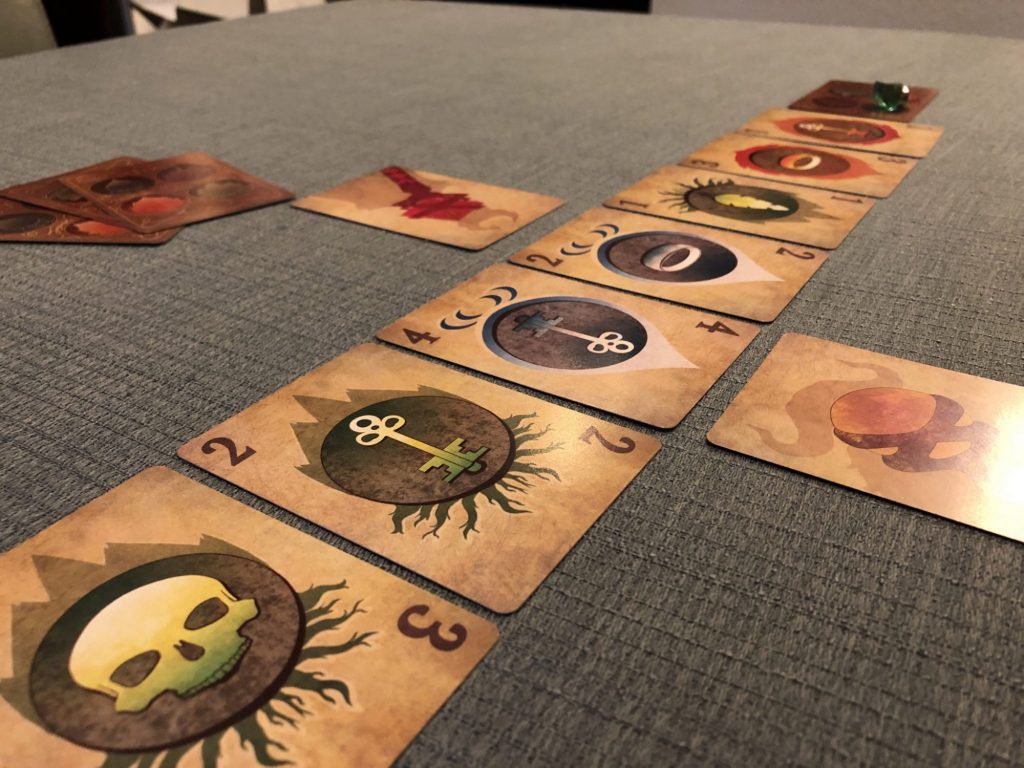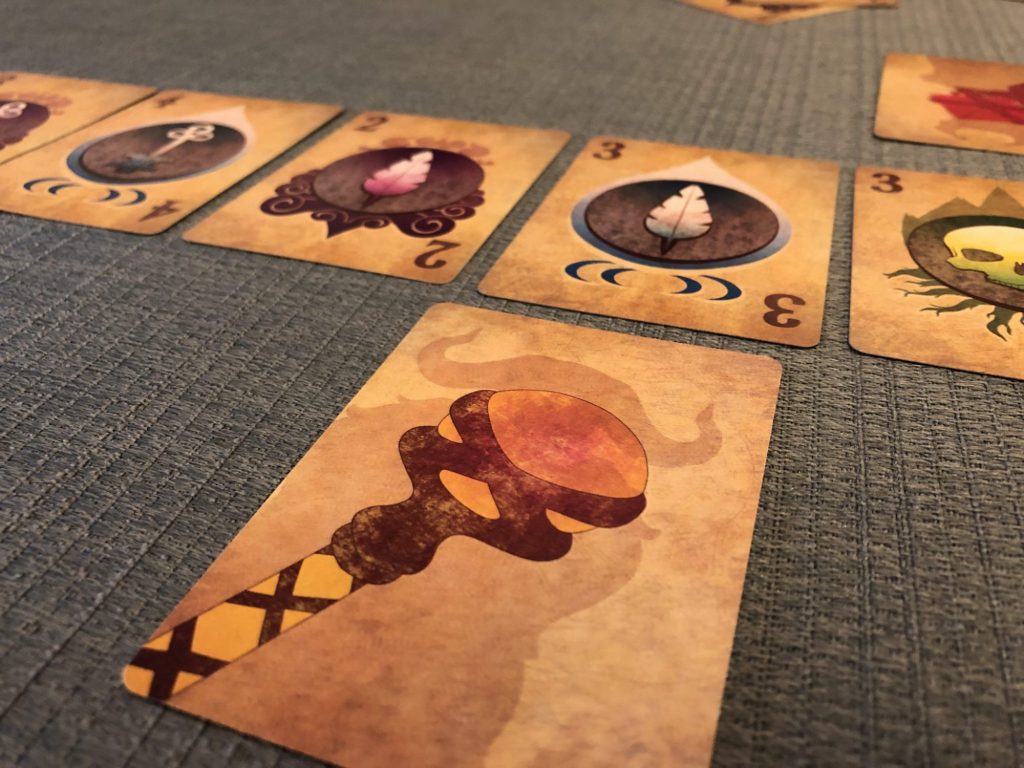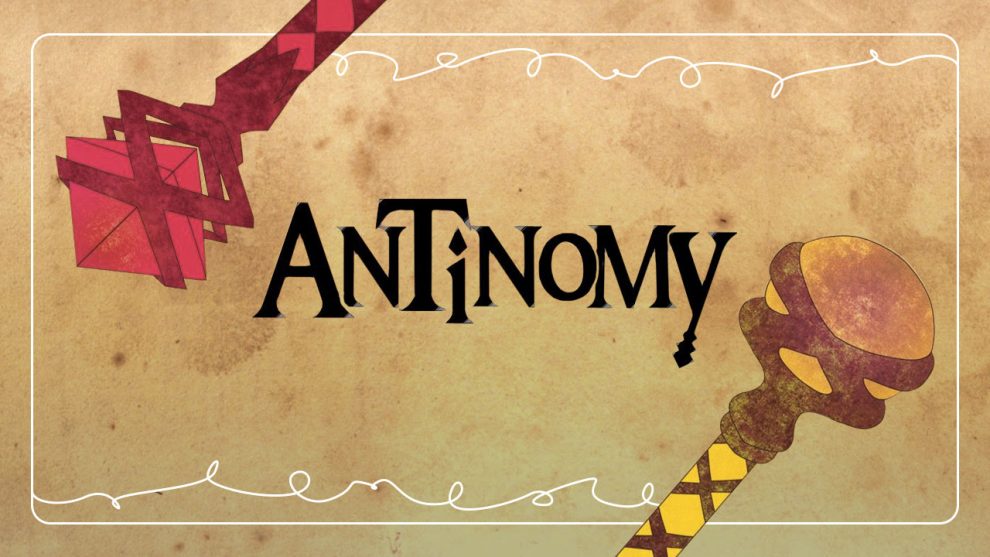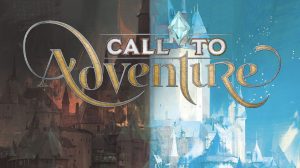Disclosure: Meeple Mountain received a free copy of this product in exchange for an honest, unbiased review. This review is not intended to be an endorsement.
In Antinomy you and another player are sorcerers trying to collect relics from the spacetime Continuum. Will you be the one sorcerer who collects enough relics to release the energy needed to capture Paradox crystals?
Setup
To get started, shuffle all 15 Relic cards and give 3 to each player facedown. Then put 9 cards face up in a straight line to make up the Continuum. The last card should be put facedown in a horizontal position at the end of the Continuum – this card is called the Codex. Place a crystal on the image on the back of the Codex that matches the color of the card on the other end of the Continuum. Then each player will take their player card (or Sorcerer) and place it under a card of the Continuum that is the same color as the one covered by the crystal on the Codex. Make sure the tip of the Sorcerer’s staff on the Sorcerer card is facing to the player’s right.

The goal of the game is to get 5 crystals first. The main way of doing this is by creating a Paradox. A Paradox is when you have a set of 3 cards in your hand that have the same color, number, or symbol; however, none of the cards in the Paradox can be the same color as the one covered by the crystal on the Codex.
Game Play
On your turn play a card from your hand and depending on which way you want to move along the Continuum will determine how the card is played. If moving to the right (Future) move your Sorcerer card the number of spaces that is shown on the card. When moving to the left (Past) move to another card to the left of your Sorcerer card that matches either the color or symbol that is on the card you played. After moving your Sorcerer card, replace the card you played with the card that is above your Sorcerer card.
For example, let’s say I play a Green Skull card that shows the number 3. I can either move my Sorcerer card 3 spaces to the right or move it to the left to another green card or to another skull card. I would then replace the Green Skull card with whichever card my Sorcerer card is now under.
At the end of your turn if the three cards in your hand create a Paradox, take a Crystal from the supply and move the crystal on the Codex clockwise to the next symbol. Shuffle the three cards in your hand and replace them with either the three cards to the left or to the right of your Sorcerer card – you will now try to use those three cards to create your next Paradox.

One last thing that may happen at the end of your turn is a Clash. This happens when you end your turn and your Sorcerer card and your opponent’s Sorcerer card are in-line with the same card on the Continuum. When this happens reveal all your cards (except for the ones that are the same color as the one that is covered by the crystal on the Codex). Whoever has the highest total value is the winner. If you both have the same amount, shuffle the same cards and place them face down. Each of you will reveal the top card and whoever has the highest card is the winner. If still a tie then no one wins the Clash. The winner will then take a crystal from their opponent; however, if the opponent does not have a crystal then no crystal is taken. You can still engage in a Clash even if you don’t have a crystal. There may be a time where you have a Paradox as well as engage in a Clash on the same turn. In this case, resolve the Paradox first and then resolve the Clash.
Play continues until one player has 5 crystals and is declared the winner!
Thoughts
I enjoy games that require you to think two or three steps ahead. This game does just that! You need to think a few steps ahead in order to get the cards you need for your Paradox. Yes, you can get your fully laid out plans thwarted by what your opponent does and there is no way to keep that from happening. I didn’t mind that too much. If my strategy got messed up I enjoyed trying to figure out if I could still use the cards in my hand or if I needed to try a different approach.

Mechanically this game is not difficult. Play a card and move your Sorcerer card along the line to get a new card to help towards getting the set you need; however, the meat comes in thinking of the best way to get what you need. I enjoy the puzzle and trying to get what I need in the shortest number of turns and I even enjoyed having to rethink my plan when things got messed up by what my opponent did.
There is some randomness to the game with how the cards are laid out at the beginning and when you replace the cards in the Continuum after you get a Paradox. That can affect how well you can strategize throughout the game and people who like to have a full strategy without the randomness will be turned off by this. My husband is one of those people, and even though he didn’t have a problem with the mechanics of the game he did not like the randomness and it affected his enjoyment of the game overall. I didn’t mind it as much and enjoyed the puzzle so much that the randomness wasn’t an issue.
Not sure I would call this a negative or a positive, but something to keep in mind and not even sure if it was a thought in the development of the game, but one strategy of the game is to gather the highest cards (highest number is 4) and then follow your opponent around and just get crystals by winning Clashes. Now, it does require you to be a bit patient as you have to wait for your opponent to get crystals, but in one of our game plays my husband did this exact thing after I had 4 crystals and ended up winning (he already had 1 crystal from getting one via a Paradox). It may not be the initial way to get the crystals but it is definitely a valid strategy and requires you to pay attention to the cards your opponent has so you make sure you can win against your opponent.

I like having the alternate strategy. It may seem a bit easier since it isn’t as much of a puzzle but you still need to keep track of your opponent. I enjoy the puzzle more but I can see why others may like this other strategy more.
I love games that incorporate their theme into the game play. This game doesn’t really do that; however, I enjoy the game play and the game doesn’t take that long (15-20 minutes) so it doesn’t bother me that the theme is just pasted on.
The footprint isn’t huge so you can play it at a restaurant while waiting for your appetizer or meal, but it may be a little too big for a tray table in an airplane. Plus the game does require players to be on the opposite sides of each other, so it may not be one you can play on a flight. But you can certainly play it on the floor of the airport as you wait to board.
Overall, I really enjoyed this light card game. It gives me enough to think about and is quick enough I can play with someone else while I wait for a meal or before I play a longer game. If this sounds interesting to you I highly recommend checking out Antinomy and getting a copy for yourself!












Add Comment